LABORgLAskAtALOg LABORATORY GLASSWARE CATALOGUE
LABORgLAskAtALOg LABORATORY GLASSWARE CATALOGUE
LABORgLAskAtALOg LABORATORY GLASSWARE CATALOGUE
Erfolgreiche ePaper selbst erstellen
Machen Sie aus Ihren PDF Publikationen ein blätterbares Flipbook mit unserer einzigartigen Google optimierten e-Paper Software.
TECHNICAL INFORMATION | PRODUCT SECTION<br />
TECHNICAL INFORMATION | PRODUCT SECTION<br />
Economy<br />
Nowadays, laboratory glassware preparation must constantly meet ever higher requirements in<br />
respect of performance and economy. Machine-based reprocessing is by comparison with manual<br />
cleaning, much more efficient: for example, the economy arises from lower time / personnel expenses,<br />
shorter process cycles as well as lower power and water consumption. In particular, the short process<br />
cycles mean the laboratory glassware is quickly ready for its next use. Minimal handling of contaminated<br />
laboratory glassware simultaneously reduces the potential risk to personnel (injury, chemical<br />
burns and risk of infection).<br />
Value retention through gentle preparation<br />
Automatic laboratory glassware preparation is gentler than manual cleaning. The glass surfaces only<br />
comes into contact with the alkalinity of the detergent for a short, defined time interval, so that glass<br />
corrosion is minimized. The accessories include special holders and locks so that the laboratory<br />
glassware is securely fastened and protected against breakage.<br />
DURAN GROUP recommends Miele<br />
To guarantee thorough, gentle and safe laboratory glassware preparation, DURAN GROUP<br />
recommends Miele washer disinfectors.<br />
Miele "Made in Germany" quality is notable for its high reliability and efficiency in day-to-day<br />
use in the laboratory. Short operating times and reliable results ensure that high-value laboratory<br />
glassware is once again ready for use after only a short period.<br />
In addition, the gentle preparation also ensures a long service life for DURAN ® laboratory<br />
glassware.<br />
empfiehlt<br />
recommends<br />
SteriliSation<br />
When preparing laboratory glass for sterile applications or as part of the cleaning process, sterilisation<br />
is a well-established process. DURAN ® laboratory glassware is suitable both for autoclaving as well<br />
as for hot air and plasma sterilisation (H 2<br />
O 2<br />
). Laboratory apparatus that has come into contact with<br />
infectious substances or microorganisms must be cleaned in accordance with the appropriate guidelines<br />
for handling these materials. As the case may be, this may include sterilisation.<br />
When carrying out sterilisation, especially of laboratory glassware, the following instructions should<br />
be observed: To avoid overpressure, all vessels should always be kept open. When sterilising media,<br />
the use of a membrane cap is recommended. Such a cap permits pressure equalisation through a<br />
PTFE membrane and hence the cap can be tightly closed. Consequently, the risk of contamination is<br />
greatly reduced.<br />
Alongside the standardised procedures described above, individually modified methods are also<br />
applicable to all DURAN ® products, for example using higher temperatures. However, you must ensure,<br />
especially with bottles (due to the screw caps) that the permissible highest temperatures for the plastic<br />
used in the accessories is not exceeded (see page 208).<br />
Working under pressure<br />
Only products whose design includes the appropriate geometry and wall thickness, and which are<br />
explicitly designated as such, are suitable for working under pressure and / or vacuum (e.g. filtering<br />
flasks, desiccators or flat flange vessels).<br />
When used under positive or negative pressure, and especially when also working with differential<br />
temperatures, additional care measures must be taken. Glass apparatus that is under pressure or<br />
vacuum should only be subject to further stress (e.g. significant temperature change) with extreme<br />
caution, as the individual resulting strains are additive and could readily result in failure.<br />
To guarantee optimum user safety, the following points should be borne in mind:<br />
• To avoid stresses in the glass, evacuated vessels or vessels under pressure should not be heated<br />
on one side or heated with an open flame.<br />
• When working under pressure the maximum figures indicated in the catalogue should not be<br />
exceeded.<br />
• Before using glass equipment under vacuum or pressure it must always be visually inspected to<br />
check that it is in perfect condition (no serious scratches, micro-cracks, abrasions, etc.). Damaged<br />
glassware should not be used for work under pressure or vacuum for safety reasons.<br />
• Never subject glassware to sudden pressure changes, e.g. always re-pressurise evacuated glass<br />
apparatus slowly.<br />
• Laboratory glassware with a flat bottom (e.g. Erlenmeyer and flat bottom flasks) should not be<br />
used under pressure or vacuum.<br />
• The plastic coating of laboratory bottles (DURAN ® protect) has no influence on pressure resistance.<br />
These products are not designed for use under pressure. For pressure applications using laboratory<br />
bottles, the DURAN ® pressure plus bottle should be used. The DURAN ® pressure plus bottle is<br />
pressure resistant from -1 to 1.5 bar due to a modified geometry and increased wall thickness.<br />
212<br />
213



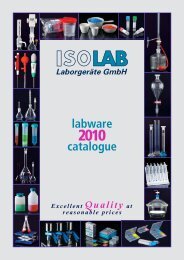
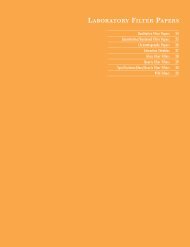
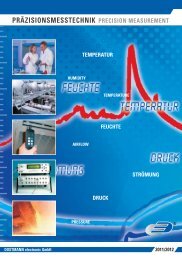
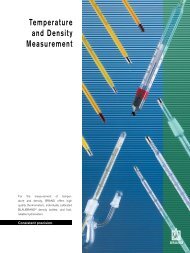
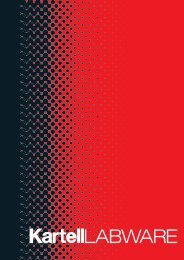

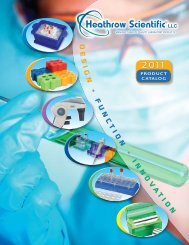


![Download [12.5MB] - Labtek](https://img.yumpu.com/24756492/1/184x260/download-125mb-labtek.jpg?quality=85)
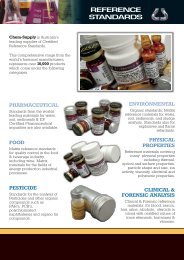
![DYMO Healthcare Brochure [2MB] - Labtek](https://img.yumpu.com/24756484/1/190x240/dymo-healthcare-brochure-2mb-labtek.jpg?quality=85)
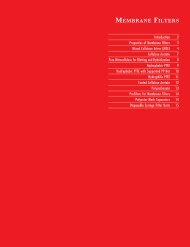
![Download [12.5MB] - Labtek](https://img.yumpu.com/24756470/1/184x260/download-125mb-labtek.jpg?quality=85)